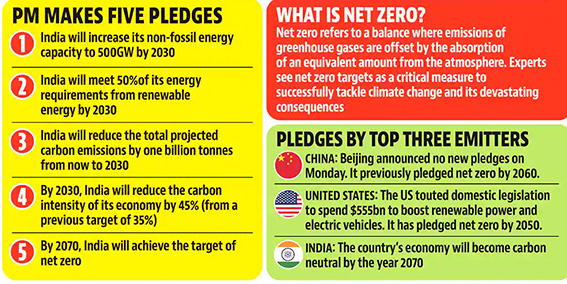Biodiversity & Environment
India to Reach Carbon Neutrality by 2070
- 02 Nov 2021
- 5 min read
Why in News
Recently, India announced that it will reach carbon neutrality by 2070 as part of a five-point action plan that included reducing emissions to 50% by 2030.
- India made this pledge at the Conference of the Parties (COP) 26 climate summit in Glasgow, where it also urged developed countries to deliver on their promise of climate financing.
- However, India hasn’t submitted an updated Nationally Determined Contribution (NDCs) with these commitments to the United Nations Framework Convention on Climate Change (UNFCCC) yet.
Key Points
- About:
- Net Zero is a state in which a country’s total emissions are offset by absorptions of carbon dioxide from the atmosphere, like that done by trees and forests, and physical removal of carbon dioxide through futuristic technologies.
- More than 70 countries have promised to become Net Zero by the middle of the century, and this is being considered vital for meeting the Paris Agreement goal of keeping global temperatures within 2 degrees Celsius from pre-industrial times.
- India’s Net Zero target of 2070 silences its critics but it is along expected lines.
- The big thing here is not the target itself but the fact that India finally relented and decided to take up a target, something it had been holding back on for quite some time.
- In its climate action plan submitted under the Paris Agreement, India had promised to reduce its emissions intensity, or emissions per unit of Gross Domestic Product, by 33 to 35% by the year 2030 compared to 2005 levels.
- Reducing India’s Emissions:
- India has the lowest per capita emissions of the world’s major economies -- emitting 5% of the total, despite accounting for 17% of the world’s population.
- According to the World Resources Institute, India’s total greenhouse gas emissions were about 3.3 billion tonnes in 2018.
- It’s projected to rise above 4 billion tonnes per year by 2030.
- That would mean between now and 2030, India could be emitting anywhere between 35 to 40 billion tonnes at the current rates of growth.
- Cutting 1 billion tonnes would, therefore, represent a reduction of 2.5 to 3% in its absolute emissions in the business-as-usual scenario in the next nine years.
- India’s New Renewables Target:
- In 2019 India announced that it would take up its installed capacity of renewable energy to 450 GW by 2030.
- At that time, India’s publicly stated target was 175 GW by the year 2022.
- The installed renewable capacity has been growing rapidly in the last few years, and the enhancement as per it’s pledge from 450 GW to 500 GW is not likely to be very challenging.
- The increase in the proportion of non-fossil fuel energy in the energy mix, to 50% is a natural corollary of this.
- Most of the new capacity additions in the energy sector are being done in the renewable and non-fossil fuel space.
- In fact, India has already said it does not plan to start any new coal power plants after 2022.
- As of now, India was already targeting 40% electricity production through non-fossil fuel sources by 2030.
- In 2019 India announced that it would take up its installed capacity of renewable energy to 450 GW by 2030.
- Climate Finance:
- India's efforts though will have to be supported by the availability of climate finance from developed countries. Without foreign capital, on concessional terms, this transition will prove to be difficult.
- India demands USD 1 trillion of climate finance as soon as possible and will monitor not just climate action, but deliver climate finance.
- Most importantly, India has called, once again, for a change in lifestyles.
- Steps Needed to Achieve Net Zero:
- According to the Council on Energy, Environment and Waters implications of a Net-zero Target for India's Sectoral Energy Transitions and Climate Policy' study, India's total installed solar power capacity would need to increase to over 5,600 gigawatts to achieve net-zero by 2070.
- The usage of coal, especially for power generation, would need to drop by 99% by 2060, for India to achieve net-zero by 2070.
- Consumption of crude oil, across sectors, would need to peak by 2050 and fall substantially by 90% between 2050 and 2070.
- Green hydrogen could contribute 19% of the total energy needs of the industrial sector.





